|
1) THE PRESIDENT'S CORNER (by Tom Steichen)
 This
month's random bits and pieces (Article 1) begins with a bit about women in the
Austrian Armed Forces, continues with a bit about where Americans were born, reports on an
Austria-wide anti-inflation plan, jumps back into the SPÖ leadership battle, then repeats (for the
third and final time) two requests for assistance, the Großpetersdorf request for materials for their 750th
anniversary book and the Vienna University student's request for interview subjects. This
month's random bits and pieces (Article 1) begins with a bit about women in the
Austrian Armed Forces, continues with a bit about where Americans were born, reports on an
Austria-wide anti-inflation plan, jumps back into the SPÖ leadership battle, then repeats (for the
third and final time) two requests for assistance, the Großpetersdorf request for materials for their 750th
anniversary book and the Vienna University student's request for interview subjects.
Our regular tidbits include the monthly BB Facebook report, book sales, a
member-recommended recipe (you should consider providing one too!) and some words for thought.
We follow that with an Ancestral Trip report to Olbendorf by Dick Schmalzl. People are
traveling again! It sounds like he and his family had a rewarding trip.
The remaining articles are our standard sections: A Historical BB Newsletter article,
Ethnic Events and Emigrant Obituaries.

Ed: Because there will not be a newsletter at the end of June, I've chosen to add
this short update to the current newsletter:
June 4 Update, Austrian SPÖ Chairmanship Election: A number of tidbits below, I reported on
the SPÖ member survey expressing preference for the party chair, but I noted that the chairmanship would
actually be determined by the formal election at the party congress on 3 June. Burgenland governor, Hans Peter
Doskozil, led the survey with 33.7% of the vote, followed by Traiskirchen mayor Andreas Babler with 31.5%, and
incumbent Pamela Rendi-Wagner with 31.3%. The remaining 3.5% of the vote was cast for "none of the named
candidates." As promised, Rendi-Walker withdrew from further participation given she failed to win the survey.
Babler said he would further contest the election and he did.
As planned, the vote of the party congress was made public yesterday with Hans Peter Doskozil being elected
as the new SPÖ party chair with 53% of the vote to 46.8% for Babler (apparently 0.2% [one vote] was for
neither). So, change will soon be coming for Burgenland.
Ed: And then I was forced to add another update!
June 5 Update: Chaos Ensues: Did you read above that I said "apparently 0.2% [one vote] was for
neither"? Well, that was an impossibility, so it had to be an invalid vote. And that led to a
re-examination of the ballots, where it was determined that the vote was indeed invalid and should have been
included in that count. But what else was discovered was that a spreadsheet transfer error had caused the votes
for Doskozil and Babler to be reversed. Thus the electoral commission has now declared Babler as the
winner of the election and released new numbers.
However, not so quick... the numbers released, a least to my eye, do not add up properly. In the first (wrong
release) it was said there were 601 votes cast, with 596 valid. Doskozil was said to have received
316 votes and Babler 279 votes, which is a total of 595 valid votes, which led to the
re-examination.
The current news release says Babler received 317 votes and Doskozil 280 votes, for a total of
597 valid votes, two more than the corrected previous valid total (which is not a simple
swapping of votes between candidates!). The news release also included the percentages these counts represent
(52.66% and 46.51%), and me, being a statistician, quickly calculated whether those percentages and counts made
sense together. The answer is, yes, but only if you bring the total to 100% by including 5 invalid votes.
But, if you do that, then the total vote count is 602, one more than the
total previously reported!
So what is correct? As of now, Doskozil
announced that he would accept defeat and withdraw from federal politics "once
and for all."
Babler, however, called for an additional review and recount, as he did not want to accept the leadership role if
the legitimacy of doing so remained in question. Such a review is underway. But, as of now, it appears there
will
not
be a leadership change coming for Burgenland.
Ed: Last update (we hope):
June 6, Babler Confirmed: The recount was completed and the corrected numbers were confirmed. As a
result, the head of the electoral commission apologized to everyone and then resigned. Now the SPÖ has the
difficult task of regaining the trust of the Austrian voters.

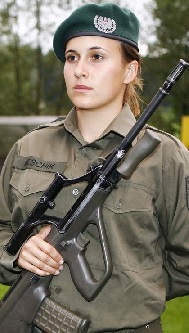 Women
in the Austrian Armed Forces: On April 1, 1998, women were first allowed to volunteer for a career in the
Austrian Armed Forces. However, 25 years later, participation by women remains limited. In Burgenland, the
proportion of women is less than three percent, whereas at least ten percent is the target. Overall, the active
military is quite small in Burgenland, meaning there is just 28 women among the 976 soldiers. Women
in the Austrian Armed Forces: On April 1, 1998, women were first allowed to volunteer for a career in the
Austrian Armed Forces. However, 25 years later, participation by women remains limited. In Burgenland, the
proportion of women is less than three percent, whereas at least ten percent is the target. Overall, the active
military is quite small in Burgenland, meaning there is just 28 women among the 976 soldiers.
Unlike men, women in Austria do not have a compulsory military commitment. Men must go through
six months of what is called "basic military service" ...essentially boot camp and initial specialized
training. Thereafter, they can opt to continue active service in the military or can move to the reserves.
Women, as noted above, can volunteer for a military career. Like as for men, volunteering involves
at least a one-year commitment and possibly as many as four years. This lengthy commitment was believed to be a
deterrent to participation. So, as of April 1, 2023, women can volunteer for just the six-month "basic
military service."
Karl Schifflhuber, from the Army Personnel Office, claims basic military service is a great
opportunity to inspire and retain people for the armed forces, saying "40 percent of the junior cadres among
the men decide to enter a cadre career during their basic military service." It is hoped that the same will
happen with women, as the program provides the same opportunities and pay as for men.
[Ed. notes: 1) The claim of 40% of junior cadres opting for a career must
refer to a subset of inductees, as the Austrian military would be much larger than it is if 40% of all Austrian
inductees stayed in the military. Recent statistics place total active Austrian military personnel at ~22,000; the
number of Austrian men reaching service age annually exceeds that, so a 40% retention among all inductees would
cause the active military to more than double in three years, and there is no indication that this is occurring.
2) Elsewhere it was stated that "The total proportion of women in the Armed Forces is 25 percent." I assume
that referred to both soldiers and civilian support personnel involved with the Austrian "Armed Forces" ...unless
the participation rate by women elsewhere in Austria is significantly different than the 3% in Burgenland, which
seems unlikely.]

For Each State, Where Were the Citizens Born? I stumbled across an interesting infographic
that I thought I would share with you.
The best infographics are dense with information yet simple to understand... and it's a bonus if they are
pretty to look at. This one does a admirable job of answering its own question: Where are Americans born?
It also gives you a clear view on trends and outliers, both nationally and regionally.
This one uses Alaska as its key at the top: As you can see, the x-axis is time, from 1850 to 2020;
the y-axis is percent of the state population; and the colors separate the population into three
groups: orange for immigrant, light blue for born in another US state, and dark
blue for born in-state, plus gray for no data. An added feature is that the states are
(roughly) arranged like they would appear on a map. Have a look:
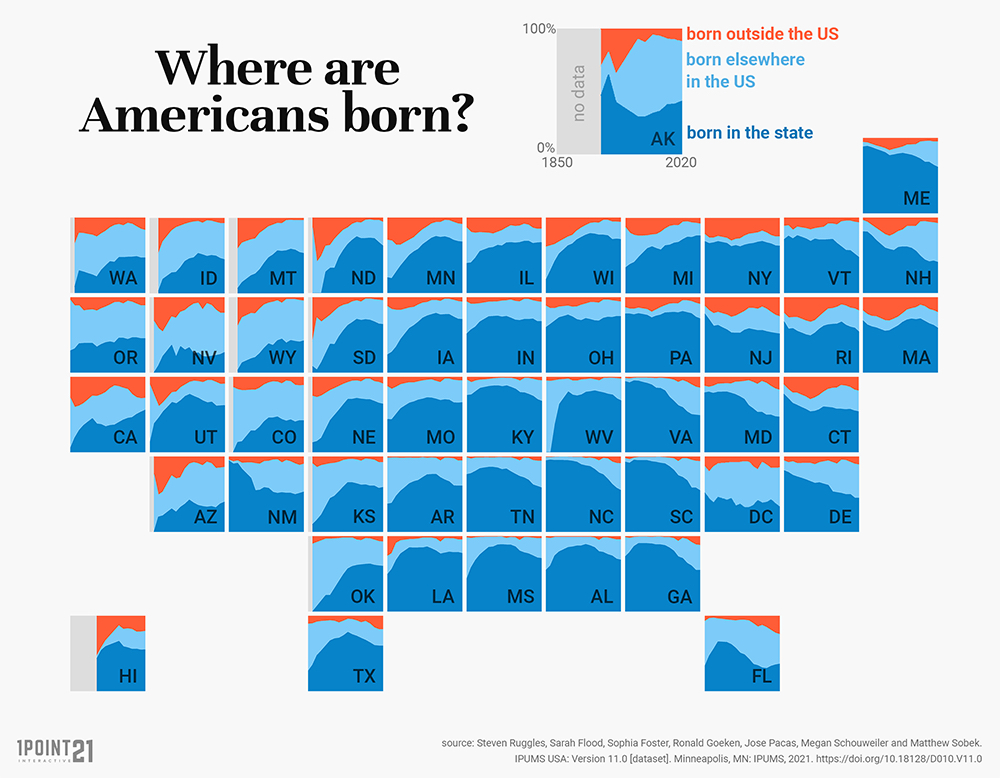
There are some interesting findings, though I'm not convinced most are unexpected. For example, Nevada has
the lowest share of residents born in-state (though Arizona is close). Conversely, Ohio and Pennsylvania have had
consistently large majorities of native-born citizens. Of no surprise, the District of Columbia is also low on
native-born. Further, a lot of the sun-states (i.e., retirement states) show decreasing proportions of native-born
residents. One exception is California, where (I think) the cost of living has discouraged out-of-state transfers.
Of some surprise to me, New York consistently has had few residents born in other states.
Given the nature of our group, I can't forget to mention foreign-born residents, who make up a significant
part of many state populations... but not all. There are relatively many immigrants in New York and California,
but relatively few in the middle-south states. The share is clearly on the increase in states like Florida and
Texas, but has been much higher in the past in the northern and western tiers of states.
An interesting anomaly: West Virginia didn’t become a separate state until 1863, which is why its “native-born”
population before 1870 was 0% (as they were all born in Virginia).
Do note that the data comes from the US Census (1850 to 1990) and American Community Surveys (2000-2020). The
older data usually does not include Native- or African-Americans, and is therefore less accurate. Nonetheless, I
hope you find it interesting!

Anti-Inflation Package in Austria: The Austrian Federal government recently announced three measures
intended to curb inflation and its consequences for the Austrian population.
The first involves energy companies, who would be taxed more heavily via profit skimming if they did
not lower prices. According to the Austrian Chancellor, Karl Nehammer, energy prices are the "root" of the
"epidemic of inflation" and it is clear that "these energy prices must come down now." The measure calls for
skimming of profits from energy companies when consumer costs exceed thresholds of 120 or 160 euros per MWh. The
excess profit tax is to come into force as early as June. According to Nehammer, this will lead to a reduction in
the customer price by a third for the currently most expensive energy supplier. [As a comparison, the current
average residential cost per MWh in the US is $165 = 151€, and select areas in the US have significantly
higher cost than this average value.]
The second measure affects grocery chains, who are to be put under greater pressure through increased price
transparency. The government wants to regularly publish the price of a defined "food basket" in a food
transparency report. Further, the food trade must publish the quantities of food made available to non-profit
organizations as donations in kind and of food that has been destroyed. However, no actual price reductions are to
be required.
The third measure involves the fees that the Federal government imposes. All federal fees will remain
frozen in the coming year and will not be adjusted for inflation. In addition, the electricity and natural gas
levy, which is currently suspended, will be suspended an additional six months. Finally, the fee measure
recommends that municipalities reduce their fees for services such as sewer and garbage; municipalities that do so
will be compensated by the federal government.
The package was immediately lambasted as too small and unlikely to reduce current costs, especially for foods.
Most Austrian states had already imposed direct price interventions in energy and a fee freeze lowers
nothing, so those measures do not change the status quo.
The government argued back that these are sustainable contributions to inflation dampening, noting that the
federal deficit has to be halved in order to get back on a sustainable path. Therefore, "expansive" measures such
as additional aid payments are "no longer expedient."

Results of the SPÖ Members Survey:

The results of the SPÖ member survey on the party chairmanship were announced Monday, May 22... and the results
were a little bit surprising to me.
Among the 147,939 SPÖ members who were entitled to vote, 107,133 questionnaires were submitted and 106,952 were
validly filled out (181 votes were ruled invalid), which corresponds to a valid voter turnout of ~72%.
The big surprise to me was that Andreas Babler polled so well, even to the extent that he garnered more votes than
incumbent Pamela Rendi-Wagner. I expected the vote to be close, but only as a two-horse race.
While this survey carries some weight, the chairmanship will actually be determined by the formal election at the
party congress on 3 June. Rendi-Wagner earlier said she would leave politics if she did not win the poll... but
with a vote this close, I thought she might be inclined to remain a candidate and take her chances with the party
functionaries she helped assemble. However, she announced her withdrawal from the party leadership on Tuesday
morning and said she will not run again at the upcoming party congress.
Babler, however, said he would run if the gap was small, and it certainly was. In fact, the under-2500 gap in
votes among the three candidates was significantly less than the 3700 who voted for none of these. Thus he
declared his continued intention to become party chairman and will compete at the party congress.
Doskozil immediately claimed the chairmanship and said the party congress should honor the vote.
As for Burgenland, Doskozil had said that he plans to relinquish the office of governor with the start of the
intensive election campaign for the National Council leadership (which would be about July 2024). Of course, that
would only occur if the party congress confirms him as chairman. In his comments after the poll results, he
acknowledged his previous statement and left unsaid who might succeed him as governor, saying instead that he
feels obliged to continue his agendas as governor. The Burgenland Green party spokeswoman was less reserved,
saying, "We have the obvious solution: Astrid Eisenkopf is a very competent deputy governor and I think we
should soon elect the first female governor of Burgenland in the state parliament." However, during a medical
leave last autumn, Doskozil was replaced by State Councillor Leonhard Schneemann, which many saw as an indication
of a possible successor. Neither the FPÖ or ÖVP opposition parties addressed the governor situation, instead both
used the poll result to claim Burgenland will suffer because Doskozil and the SPÖ will be distracted.
Thus the drama continues.

 Großpetersdorf 750th
Anniversary Book: I recently received a request from Dr. Gerhard Baumgartner, a historian from Vienna. He
said that the municipality of Großpetersdorf will soon be celebrating the 750th anniversary of its first
documented existence, so wants to publish a history of Großpetersdorf and the four villages
belonging to it: Welgersdorf, Kleinpetersdorf, Kleinzicken and
Miedlingsdorf. He has been commissioned to put together this volume (I have confirmed this) and is looking
for documents and photographs of all kinds of things relating to either the history of the villages or the
families that left for the USA, Canada, and South America. Großpetersdorf 750th
Anniversary Book: I recently received a request from Dr. Gerhard Baumgartner, a historian from Vienna. He
said that the municipality of Großpetersdorf will soon be celebrating the 750th anniversary of its first
documented existence, so wants to publish a history of Großpetersdorf and the four villages
belonging to it: Welgersdorf, Kleinpetersdorf, Kleinzicken and
Miedlingsdorf. He has been commissioned to put together this volume (I have confirmed this) and is looking
for documents and photographs of all kinds of things relating to either the history of the villages or the
families that left for the USA, Canada, and South America.
He tells me that he has, so far, concentrated on finding relevant material in the Hungarian archives, but he soon
realized that the material about emigration is especially weak. He went on to note that this especially true for
Welgersdorf, a place where he has been led to believe had many migrants to the US—apparently about 400—but he says
it is a lot of rumors with very few hard facts and very few photographs.
Therefore, he is requesting its emigrants and the descendants of its emigrants to provide documentary materials,
both for Welgersdorf and the other villages in the municipality. If you have ancestral items related to the
municipality... village and/or emigrant photos, passports, travel documents, heirlooms, diaries,
emigrant/emigration stories, etc., please consider sharing these. Dr Baumgartner states that, "All materials
will be archived digitally at the city hall. If the owner agrees, some will be published on the city homepage and
in the printed volume in September. Owners of published materials will get a free copy of this book."
From this, it is evident that you will retain your original items and copyrights, as only digital copies will be
used in this project. And given that digital is how this will be done, it is extremely important that the scans
and photos be of as high quality as possible.
Dr. Baumgartner's email address is gerhard.baumgartner57@gmx.at.
Please reach out to him for more details if you believe you have materials of interest for this project.
This is a project for which I strongly encourage you to respond if you have appropriate materials!

 Vienna
University Student Needs Interview Subjects: Nikola Blagojevic, a Master's candidate at Vienna
University in the Department of Social and Cultural Anthropology, needs digital interview
subjects for a class project regarding Burgenland's natural environment. I have confirmed that he is, in fact, a
student there and that this is a legitimate request. Therefore, I am asking you to assist him by participating. I
will present his request then add a few additional comments. Vienna
University Student Needs Interview Subjects: Nikola Blagojevic, a Master's candidate at Vienna
University in the Department of Social and Cultural Anthropology, needs digital interview
subjects for a class project regarding Burgenland's natural environment. I have confirmed that he is, in fact, a
student there and that this is a legitimate request. Therefore, I am asking you to assist him by participating. I
will present his request then add a few additional comments.

Nikola writes:
Dear BB members! I am a student at the University of Vienna conducting research on the Perception of the
Environment at the National Park Neusiedlersee-Seewinkel for my ethnographic course. The research also
encompasses the perception of the general environment of Burgenland. Due to the intended digital methodology of
this project, I wish to talk via email with people from the United States who are affiliated with the Burgenland
ecosystem in some way.
As we know, nature is almost always intertwined with our lives, so I would like to hear about your personal
experiences or family stories related to Burgenland. In order to achieve this, I have prepared a number of
questions that can be answered by email. Of course, if there are other things you would like to add or talk about
in relation to Burgenland's environment, please do so. My email address is
niko.bvic@gmail.com.

Editor: Nikola's project centers on the Neusiedlersee and the Seewinkel (but also
includes the whole of Burgenland). Still, he has special interest in those of you who are familiar with
this part of Burgenland. He also has special interest in BB members who live in Burgenland or frequently visit it.
If you fit these categories, please strongly consider responding. Nonetheless, participation by people interested
in other parts of Burgenland are needed.
Nikola has prepared nine questions, shown below, that they ask you to respond to. Please copy these questions,
paste them into an email, then provide written responses. The questions provide some guidance on the level of
detail desired but you may respond as you see fit. Your responses should be sent to:
niko.bvic@gmail.com. He may have follow-up questions to clarify or expand
answers.
(If you are unable to move the questions to an email, just write to Nikola and ask to have the questions provided
directly in an email.)
Also, according to data privacy laws and school policy, Nikola is required to obtain written consent from each
interviewee to be able to use your data, thus you will need to give your consent. The University of Vienna
provides a standard consent page and corresponding privacy notice for this purpose, which I have translated to
English. You can read them here: Consent/Privacy. However, it is sufficient merely
to acknowledge that you have read and agree to these documents, so a one-sentence "consent to use data" has been
added to the bottom of the questions. Please fill in your name in the space provided and send it with your answers
when done.
Again, I strongly encourage you to respond.

Questions:
Part A: Please provide brief answers to these questions:
1. What is your relationship to Burgenland? That is, are you an emigrant or a descendant of an emigrant, and, if
so, when did the emigrant emigrate and from which village?
2. Why did you or your ancestors migrate to the US?
3. Have you ever visited Burgenland? If so, which parts and when?
4. What do you like the most about Burgenland?
Part B: Please provide moderate answers to these questions:
5. Please share any stories about Burgenland regarding its lifestyle and, if possible, about the environment,
either in the past prior to migration or in the present. For example, your family stories and experiences.
6. Do you have any contact with any of the Burgenland residents today? If so, do you talk about life and the
environment in Burgenland? If so, please describe.
Part C: Please provide extended answers to these questions:
7. Taking into account the aforementioned questions about family history and life in Burgenland, would you say
that you feel connected to nature in Burgenland - in the sense that you are familiar with how people
perceived the environment and the role it played in their lives, both past and present?
8. Do you know how people in Burgenland take care of their natural habitats? If so, please describe.
9. Are you aware of how nature affects people, and do you know how they perceive the environment in Burgenland
today and in the past? For example, agriculture, economy, climate, wildlife, tourism, water, and biodiversity.
Please describe.
Consent to use data:
I (place your name here) have read the consent form and privacy notice provided by
the University of Vienna and hereby give my consent to use this interview data under the conditions
described.

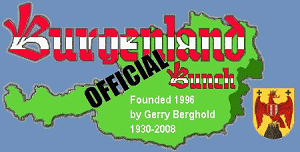 The
Facebook Bunch (from Vanessa Sandhu): The
Facebook Bunch (from Vanessa Sandhu):
Greetings, Burgenland Bunch!
I hope that this message finds you all happy and healthy! Here is a little review of what we had going on in our
Facebook group in May. We gained 11 new members and our membership count now stands at 2031. If you are
missing from this number, please come join us! We would love to have you!
facebook/TheBurgenlandBunchOFFICIAL/
BB staff member Johnny Santana provided us with a “Save the Date” for the First
Burgenländer Austria SC’s 100th Anniversary Celebration. It will be held on Sunday, October 22nd, 2023 at the
Plattduetsche Park Restaurant, 1132 Hempstead Turnpike, Franklin Square, NY. More details will be
forthcoming, and we will be sure to share those with you as they become available.
Speaking of fun events, The Coplay Sängerbund will host its Stiftungsfest on Sunday, June 25th,
2023. Music begins at 2:30 pm. The Coplay Sängerbund Chorus and visiting guest choruses will perform. The
Emil Schanta Band will also be playing afterwards. The event is open to the public. The Sängerbund
is located at 205 S. 5th Street, Coplay, PA 18037.
Member Fred Knarr shared photos from his trip to the Austrian consulate in New York
City as his daughter obtained her Austrian passport. He said the staff was wonderful, in case anyone ever needs
their assistance!
I was fortunate enough to be able to attend 2 great events at the Coplay Sängerbund this month. I got to
see the Alex Meixner Band perform and they were fantastic. As mentioned last month, Alex comes from the
very musical Meixner family hailing from Eisenberg an der Pinka. He played many traditional songs and had a great
gathering of local polka musicians join him on stage. I also got to attend the Maifest a few days later.
Kudos to the Coplay Sängerbund’s Heritage Committee! They always do an amazing job of keeping the
Burgenländer culture alive and well. I have many videos and photos of the events in the Facebook group, so
if you are longing to hear some traditional music, swing on by and have a listen!
Member Christine Rubba shared a great video showing the members of the fire department
setting up the Maibaum. It is very neat to see!
Member Martin Wolf shared many excellent historical photographs from Neuhaus am Klausenbach.
We had many queries about long-lost relatives this month, but our amazing members managed to find almost every
single one! If you are trying to break down a brick wall in your genealogy search, let us know. We love to help!
Until next time, be well!
Vanessa

 Update
for book "The Burgenländer Emigration to America": Here is this month's update on purchases of the English
issue of the 3rd edition of Dr. Walter Dujmovits' book "Die Amerika-Wanderung Der Burgenländer." Update
for book "The Burgenländer Emigration to America": Here is this month's update on purchases of the English
issue of the 3rd edition of Dr. Walter Dujmovits' book "Die Amerika-Wanderung Der Burgenländer."
Current total sales are 1720 copies, as an interested person purchased 1 book during this past month.
As always, the book is available for online purchase at a list price of $8.89
(which is the current production charge for the book, as we purposely choose not to make a profit so we can
avoid dealing with the income tax consequences and so you can obtain the book at as low a cost as
possible!), plus tax & shipping. Unfortunately, the price above is somewhat higher than in previous months, as our
on-demand publisher, Lulu, recently raised is printing prices by 9.5%, meaning we must charge more. See the
BB homepage for a link to the information / ordering page and for information
about current discounts (there is at least one discount on price or shipping available most of the time... if not,
wait a few days and there will be one!).
The book is an excellent read for the Burgenländers in your family.

Burgenland Recipes: Many of our recipes have been passed down from grandparents
or earlier, but as time passes, we recede farther from those generations, and the originals are becoming lost to
time. To supplement our collection, we have featured some from cookbooks compiled from the originals. Others are
from more current sources that capture the vibe but are from material like recent magazine articles. Moving
forward, we may from time to time rely on our members' memories or personal experimentation to help fill this gap.
Steve Lamberty and his mom were searching Internet recipes and found a variation of potato salad
which was very similar to what his family used to make. To provide due credit, the original recipe, along with
additional photos and notes, can be found on foodie Aleksandra's website Everyday Delicious at
this link.
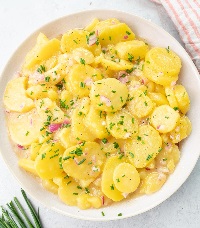 Austrian Potato Salad
Austrian Potato Salad
(suggested by Steve Lamberty)
Ingredients:
- 2 lbs (900g) salad potatoes, preferably uniformly sized
- 1-1/3 cups good quality beef broth or chicken broth
- 3 Tbsp white wine vinegar
- 1 Tbsp tarragon mustard or Dijon mustard
- 2 tsp sugar
- 1 medium red onion (finely chopped)
- 1/4 cup vegetable oil
- salt and pepper to taste
- chives to garnish
Instructions:
- Wash the potatoes and add them to a pot (don't peel them). Cover with water, salt the water. Bring to a
boil and cook for about 20-25 minutes or until the potatoes can be easily pierced with a fork.
Make sure to not overcook them (or they will fall apart).
- While the potatoes are cooking, cook the broth in a small pot until reduced in half so you should end up
with 2/3 cup of broth. Set aside.
- When the potatoes are cooked, drain them and leave to cool down slightly - they should be cold enough to
handle but still very warm.
- If the broth got cold, heat it again until very hot, take off the heat. Add the vinegar, mustard, and
sugar. Whisk until combined. Add finely chopped red onion. Add the sauce to a large bowl.
- Now you need to combine the sauce and the potatoes - both should be warm!
- Peel one potato, cut it into slices and add to the sauce, stir with a wooden spoon. Repeat for the
remaining potatoes, adding them to the sauce and stirring after every added potato. The salad will look soupy
at first, but it will thicken.
- Now leave the salad for 30 minutes to rest and stir it every 10 minutes with a wooden
spoon. After this time the potatoes should absorb some of the sauce and the remaining sauce should thicken.
- Add the vegetable oil, season the salad with salt and pepper, and stir everything together.
- Garnish with finely chopped chives and enjoy! It tastes good warm and cold.
Notes:
- The best potatoes for a potato salad are waxy potatoes or all-purpose potatoes (white, red, fingerling,
Yukon Gold). Do not use starchy/mealy potatoes, such as Russets, for this salad.
- The potatoes should be uniformly sized - they will cook evenly.
- Use neutral-tasting vegetable oil such as canola oil or sunflower oil, not olive oil.
- If you don't have a good-quality beef broth, it's better to use chicken broth.
- Tarragon mustard is traditionally used in this recipe and can be found in every grocery store in Austria.
It tastes more mild and herby than Dijon mustard. You can use Dijon mustard instead but the salad will taste a
little bit different.
- Sugar is necessary to balance the sourness from the vinegar and mustard.
- You can add some caraway seed to the potatoes while they're cooking.

 Note:
Our recipes sortable list has links directly to the recipes or food-related articles
published in our past newsletters. You can access the list by clicking our recipe box (to the right). Thanks to
the contributions of our members over the years, we have quite a collection of Burgenland recipes, some with
several variations. Note:
Our recipes sortable list has links directly to the recipes or food-related articles
published in our past newsletters. You can access the list by clicking our recipe box (to the right). Thanks to
the contributions of our members over the years, we have quite a collection of Burgenland recipes, some with
several variations.
However, whenever we use up our unpublished recipes, this recipe section will become dormant. So, if you have a
favorite family recipe, please consider sharing it with us. We will be happy to publish it. Our older relatives,
sadly, aren't with us forever, so don't allow your favorite ethnic dish to be lost to future generations.
You can send your recipe to BB Recipes Editor,
Alan Varga.
Thanks!

Words for Thought:
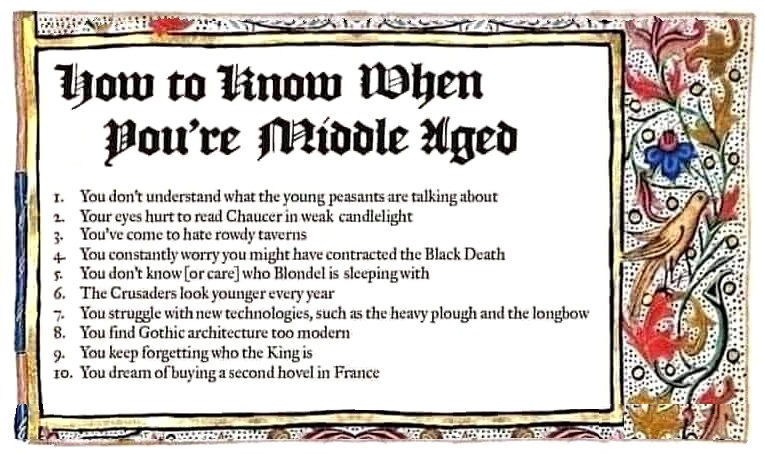
|
3) HISTORICAL BB NEWSLETTER ARTICLES
Editor: This is part of our series designed to recycle interesting articles from the BB Newsletters of
10 years ago. This month I'm rerunning four short items from my bits and pieces from 10 years ago, as each
remain relevant today. I will insert short, current commentary on each.

THE BURGENLAND BUNCH NEWS No. 233
June 30, 2013
THE PRESIDENT'S CORNER (Bits and Pieces, June 2013):
Email-Harvesting Spiders and the BB: A concern when one runs a public website is security. Below is
an exchange (one of two I had in recent months) where a person was concerned about the security of the information
on the BB website. While I consider the BB website to be adequately secured (as you will see if you read below), I
ask that you contact me if you have reason to believe otherwise. If necessary, the BB will takes steps to correct
any problem that becomes evident.
A potential new member wrote (in part):
I am very interested in joining the Burgenland Bunch and have visited your website quite a few times. But
I am concerned about my name and email address appearing on your list of members on the internet. I think that
information can easily be scanned by the automated robots in use all over the internet to pick up names and
email for spamming purposes. Has this issue been discussed by your members in the past? I wondered what others
think about this. I'd like to join, but I am a bit concerned about how public our information is on your
(wonderful) site.
I replied (in part):
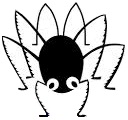 The BB website
walks a careful line between sharing information (which is our purpose) and defeating web-harvesting spiders.
There is actually some anti-robot coding in use, so what is in the underlying page code (which is what a robot
reads) is not the same as what you see (specifically, email address are not in the underlying code in the form of
a standard address, so robots do not see them). We implemented that system seven years ago and complaints/concerns
by members have essentially disappeared. Before that, rightly or wrongly, we did receive complaints. The BB website
walks a careful line between sharing information (which is our purpose) and defeating web-harvesting spiders.
There is actually some anti-robot coding in use, so what is in the underlying page code (which is what a robot
reads) is not the same as what you see (specifically, email address are not in the underlying code in the form of
a standard address, so robots do not see them). We implemented that system seven years ago and complaints/concerns
by members have essentially disappeared. Before that, rightly or wrongly, we did receive complaints.
Having said that, there is no way to provide shareable information that a dedicated programmer can’t figure out
how to harvest… but one website is usually not worth their time and we have no indication that our system has ever
been decoded. If we did feel it had been broken, we’d rewrite our code (which is easy for us) and break their
harvester again… and they know we’d do that so they don’t bother; there are easier ways to get email addresses!
Based on our tracking software, we know our pages are scanned by 15-20 robots every month (some are good ones,
like Google, etc.; others are bad boys); as I said, there is no evidence that any of these are breaking our code.
Generally, I consider the BB website to be low risk to our members. Nonetheless, you’ll have to decide for
yourself. Truthfully, if people can’t contact you, there is little reason to put your information on our site…
and, in reverse, other people’s info would be of little use if you could not contact them.
Thanks for the kind words about the BB.
Ed 2023: I'm pleased to note that we still use the same anti-robot coding from 10 years ago and that it
apparently remains effective, as we continue to receive no complaints from you our members!

Another Burgenland? Are you aware that there is another region in Europe that is known as
"Burgenland"? There is, and it is situated below a region known as Heideland, much like the
Heideboden of Hungary abuts our northern Burgenland!
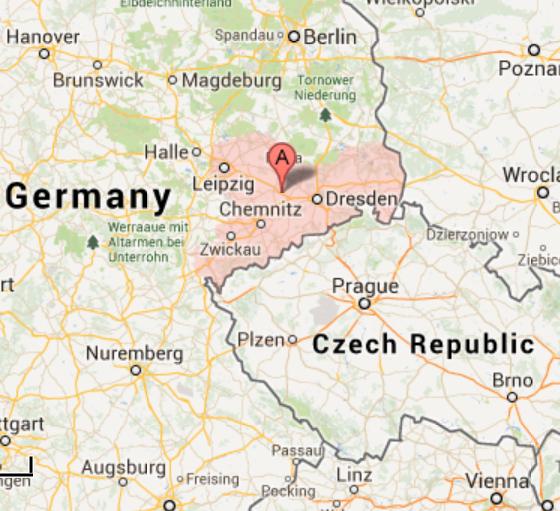 This
Burgenland—unlike our Burgenland—is so-named because of the many castles in the area (one of its
advertising slogans is that "a detour here is to visit the Middle Ages"); its name is not an official
governmental-unit designation of any kind (although there is a Burgenland Kreis (District=County) in the
neighboring German state). Both this Burgenland and its neighboring Heideland are found in the
center of the German state of Saxony, beside Poland and above the Czech Republic, and between Leipzig and Dresden
(marked 'A' in the map to the right). It generally follows the Mulde and Zschopau River valleys, with
Romanesque castles perched on cliffs or on the densely wooded hillsides above the rivers. This
Burgenland—unlike our Burgenland—is so-named because of the many castles in the area (one of its
advertising slogans is that "a detour here is to visit the Middle Ages"); its name is not an official
governmental-unit designation of any kind (although there is a Burgenland Kreis (District=County) in the
neighboring German state). Both this Burgenland and its neighboring Heideland are found in the
center of the German state of Saxony, beside Poland and above the Czech Republic, and between Leipzig and Dresden
(marked 'A' in the map to the right). It generally follows the Mulde and Zschopau River valleys, with
Romanesque castles perched on cliffs or on the densely wooded hillsides above the rivers.
The Heideland, is heathland, with the Dahlen and Duebener heaths being the major nature and cycling
attractions.
So, if you see the names Burgenland and Heideland associated with Germany, now you know why. If
interested, you can visit its (German-language) website at
http://www.saechsisches-burgenland.de/.
Ed 2023: This bit remains relevant today and the link above for that other Burgenland is still active!

The "Other" Lakes of the Seewinkel: On April 13, the Austrian Times published a short article
entitled "Forgotten
Lakes Return to North Burgenland."
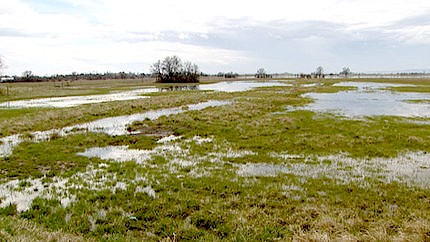 Due to the heavy
precipitation of last winter, coupled with spring rains, the Seewinkel region in Burgenland has standing water in
many meadows and fields. The article calls this a "spectacle of nature" and a "flashback
to a long forgotten time." Due to the heavy
precipitation of last winter, coupled with spring rains, the Seewinkel region in Burgenland has standing water in
many meadows and fields. The article calls this a "spectacle of nature" and a "flashback
to a long forgotten time."
However, this flooding should not be a great surprise; after all, these meadows and fields were
created on the dry beds of lakes drained many years ago. Nonetheless, it is a situation that, according to
Thomas Zechmeister, head of the biological station in Illmitz, "only occurs every few decades or centuries." How
long will the water remain? He says that "will depend on the upcoming weeks and months: if the regular rainfalls
stop occurring, the important bird habitats will soon vanish." But for now... well, there are more lakes in the
Seewinkel!
Ed 2023: This bit struck me as interesting because I have been running a series of bits over the past
months about the severe drought in the area and the drying up of the salt lakes that exist there in "normal"
times. Historically, water levels in this region has been subjected to great variation. Although the bit above is
from the June 2013 edition, the May 2013 edition had a full article on the Seewinkel (Lake Corner) that included a
map showing high waters in the 1700s (I think, but we did not date the map in the 2013 article). I include below
it a current GoogleMaps clip of essentially the same region so you can see what is now dry land versus the open
water and swamps from back then:
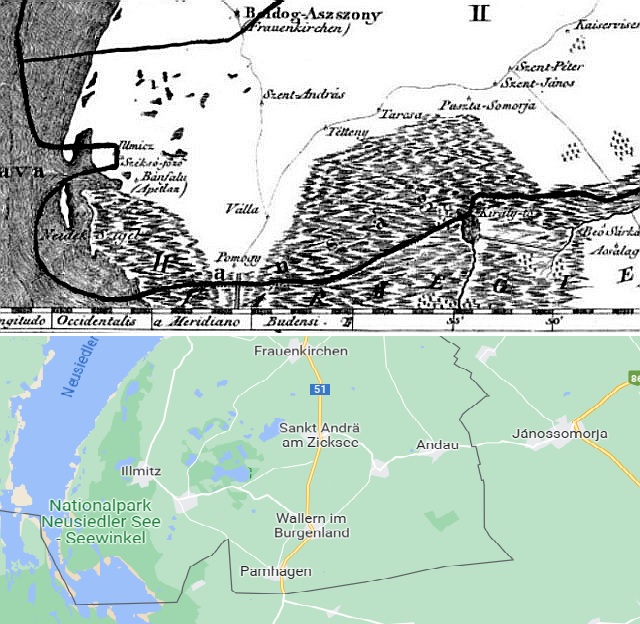

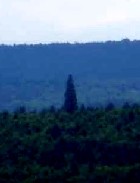 An
"American Immigrant": Hannes Graf recently sent a message that included a photo, entitled "Grösster Baum"
(clicking the thumbnail clip to the right will open to the full picture), that he recently took. His message read: An
"American Immigrant": Hannes Graf recently sent a message that included a photo, entitled "Grösster Baum"
(clicking the thumbnail clip to the right will open to the full picture), that he recently took. His message read:
Hello all, I found an "American immigrant" in Burgenland, which lives in the middle of nowhere in a
forest beside Oberpetersdorf.
While it was obvious to me that this was indeed, by far, the Grösster (largest) tree in this forest, it
wasn't clear why Hannes called it an American immigrant, so I inquired. Hannes replied by sending two more
pictures and an explanation. He said:
It's a 50m redwood tree (Sequoiadendron giganteum) in the middle of European mixed (very rare, especially
in Burgenland; I know that one, in-between 2 other, but not so tall).
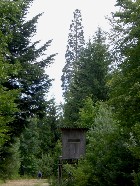 A
little reading in Wikipedia quickly informed me that the only natural stands of Giant Sequoia (Redwood) are in
California, so that explains Hannes' American immigrant notation... but what was a 50m tree doing in
Burgenland? A
little reading in Wikipedia quickly informed me that the only natural stands of Giant Sequoia (Redwood) are in
California, so that explains Hannes' American immigrant notation... but what was a 50m tree doing in
Burgenland?
Further reading said that Sequoia require particular conditions to reseed themselves; in particular, a
low-intensity burn off of ground cover to release the seeds from the cone, give actual, moist soil for them to
embed in, and to allow enough sunlight for the seedlings to thrive. These are not seeds that can be carried by
birds or animals and replanted a long way from the mother tree. So again, why is there one so large (and
apparently two smaller ones) in Burgenland?
A 50m Sequoia is big... normally they grow to 50 to 85m tall, with the very fastest growing taking a full 150
years to reach 50 meters! So this is an old tree too (well, young in Sequoia years, given some are over 3500 years
old, but old in people years).
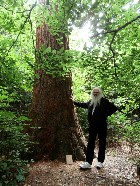 Thus
this tree likely took root sometime before 1860, which was well before my Burgenland ancestors emigrated! Thus
this tree likely took root sometime before 1860, which was well before my Burgenland ancestors emigrated!
Still further reading in Wikipedia reveals that man is responsible for spreading Sequoia trees to Europe. Such
trees were planted across Europe after William Lobb, acting for the Veitch Nursery at Budlake near Exeter,
England, sent a large shipment of seed that was collected in 1853 in the Calaveras Grove of California (the place
where most well-known pictures of Giant Redwood were taken). Seed from this batch was widely distributed
throughout Europe and is the likely source for the tree Hannes found. With luck, this tree will still be standing
when our 13,000th generation of grandchildren are born... quite a thought, eh?
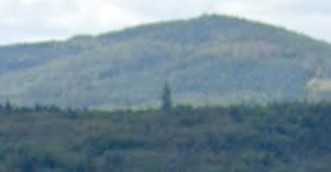 Ed 2023: I
became curious whether I could find Hannes' Grösster Baum via GoogleMaps, as I certainly expected the tree to
still exist. A surprise, though, was that it is now a labeled "tourist attraction" (perhaps Hannes started
something!). While I could not figure out where Hannes snapped his long-distance image (the first above), I was
able to find a similar "Street View" image when positioned on the Schnellstraße across the valley and above
Oberpetersdorf. To no surprise, it looks very similar 10 years later! Ed 2023: I
became curious whether I could find Hannes' Grösster Baum via GoogleMaps, as I certainly expected the tree to
still exist. A surprise, though, was that it is now a labeled "tourist attraction" (perhaps Hannes started
something!). While I could not figure out where Hannes snapped his long-distance image (the first above), I was
able to find a similar "Street View" image when positioned on the Schnellstraße across the valley and above
Oberpetersdorf. To no surprise, it looks very similar 10 years later!
|
 On
April 6, 2023, my wife and I, and our three adult children and their spouses had a wonderful visit to Olbendorf,
Austria, in the heart of Burgenland. We began planning a European family vacation in October 2022, which included
a few days in Vienna. I knew that all four of my grandparents emigrated from Austria to the US in the early 1900s,
but had very little family history about their roots. Starting with basic Google searches of their
surnames—Holpfer, Herzlieb and Schmalzl, I soon discovered that all four of my grandparents are listed in the
historical pages of the Burgenland Bunch. Those pages showed the villages where they emigrated
from—Olbendorf, Felsőrönök and Pornóapáti, respectively, their dates of birth and death, and the
On
April 6, 2023, my wife and I, and our three adult children and their spouses had a wonderful visit to Olbendorf,
Austria, in the heart of Burgenland. We began planning a European family vacation in October 2022, which included
a few days in Vienna. I knew that all four of my grandparents emigrated from Austria to the US in the early 1900s,
but had very little family history about their roots. Starting with basic Google searches of their
surnames—Holpfer, Herzlieb and Schmalzl, I soon discovered that all four of my grandparents are listed in the
historical pages of the Burgenland Bunch. Those pages showed the villages where they emigrated
from—Olbendorf, Felsőrönök and Pornóapáti, respectively, their dates of birth and death, and the
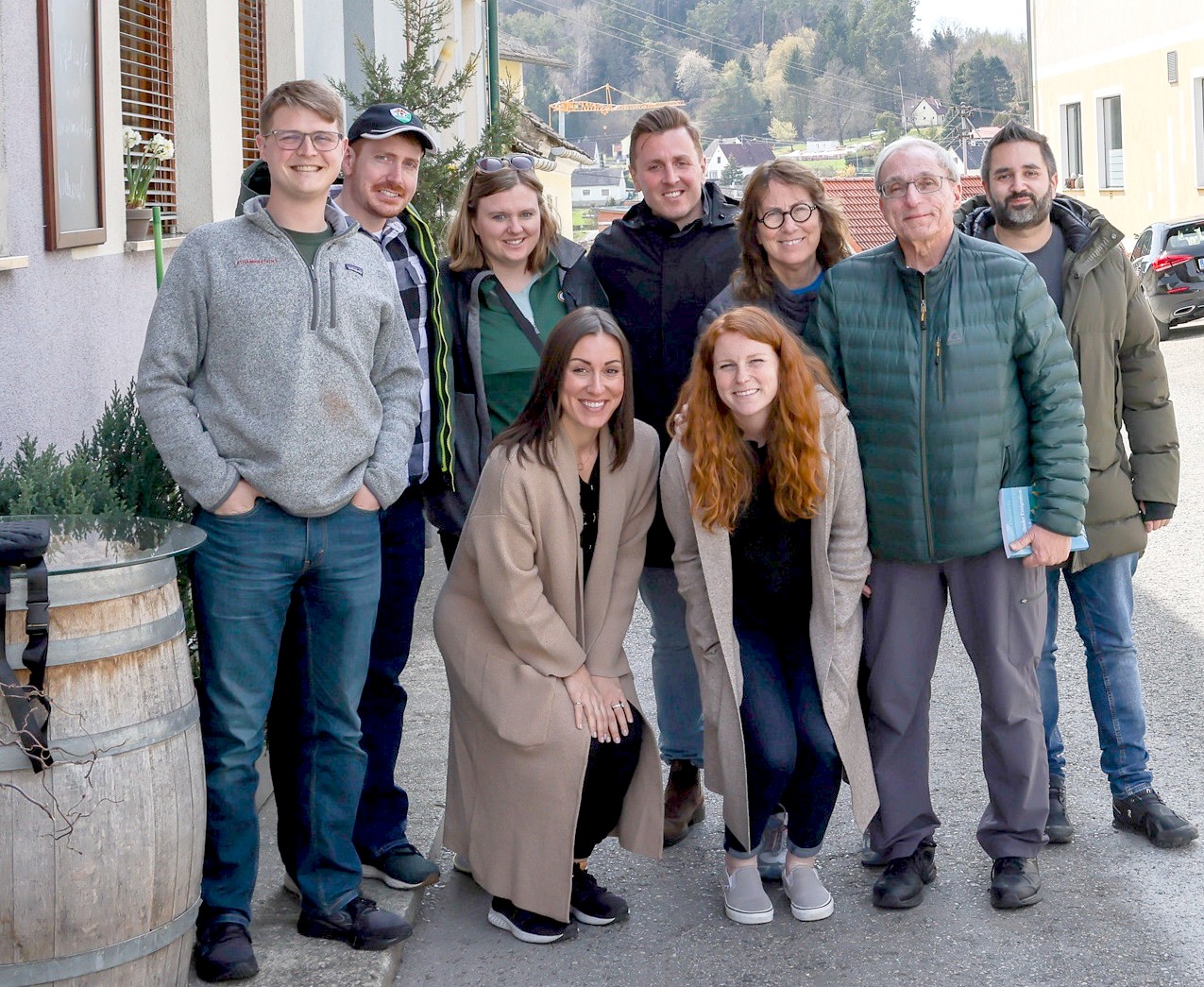 cemeteries
where they are buried in Western Pennsylvania. Knowing the latter information was all correct, I was confident
that the hometown information was accurate also. Given the proximity of Vienna to these villages, we decided to
dedicate one day of our vacation to visiting one or more of these three villages.
cemeteries
where they are buried in Western Pennsylvania. Knowing the latter information was all correct, I was confident
that the hometown information was accurate also. Given the proximity of Vienna to these villages, we decided to
dedicate one day of our vacation to visiting one or more of these three villages.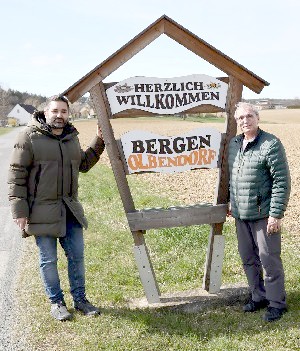 Although
I had visited the Burgenland Bunch website on numerous occasions, I finally noticed that it was easy to
sign up to become a member. By nature, I’m not one who likes to sign up for things but thought that, maybe by
becoming a member, I might discover some additional resources to help me identify a tangible link to my
grandparents’ lives in Burgenland. As it turned out, I hit the jackpot! Within a day of submitting my membership
form, I received a response from Patrick Kovacs, BB New Member Outreach. To my astonishment, not only did
Patrick welcome me to the Burgenland Bunch, but he informed me that he is my fourth cousin, twice
removed, that he works in Vienna and lives in Olbendorf!
Although
I had visited the Burgenland Bunch website on numerous occasions, I finally noticed that it was easy to
sign up to become a member. By nature, I’m not one who likes to sign up for things but thought that, maybe by
becoming a member, I might discover some additional resources to help me identify a tangible link to my
grandparents’ lives in Burgenland. As it turned out, I hit the jackpot! Within a day of submitting my membership
form, I received a response from Patrick Kovacs, BB New Member Outreach. To my astonishment, not only did
Patrick welcome me to the Burgenland Bunch, but he informed me that he is my fourth cousin, twice
removed, that he works in Vienna and lives in Olbendorf!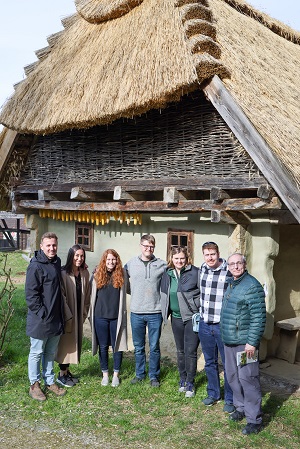 and
the best Austrian food of our entire vacation. After lunch, Patrick had arranged that the caretaker of the
Laurentius Kirche opened it up especially for us. Given that it is the only Catholic church in Olbendorf and
has been there since the 18th century, it was surely the church where my grandmother would have been baptized, my
great-grandparents married, and undoubtedly many other of my Holpfer ancestors as well. Sitting on a hill, the
church also served as a scenic overlook for viewing the beautiful village of Olbendorf. We then said farewell to
Patrick and continued on to see the open air museum of historical houses in nearby Gerersdorf and the imposing
Güssing Castle in Güssing. Along the way and including our round trip from Vienna, we thoroughly enjoyed the
Burgenland scenery.
and
the best Austrian food of our entire vacation. After lunch, Patrick had arranged that the caretaker of the
Laurentius Kirche opened it up especially for us. Given that it is the only Catholic church in Olbendorf and
has been there since the 18th century, it was surely the church where my grandmother would have been baptized, my
great-grandparents married, and undoubtedly many other of my Holpfer ancestors as well. Sitting on a hill, the
church also served as a scenic overlook for viewing the beautiful village of Olbendorf. We then said farewell to
Patrick and continued on to see the open air museum of historical houses in nearby Gerersdorf and the imposing
Güssing Castle in Güssing. Along the way and including our round trip from Vienna, we thoroughly enjoyed the
Burgenland scenery.  News
News This
month's random bits and pieces (Article 1) begins with a bit about women in the
Austrian Armed Forces, continues with a bit about where Americans were born, reports on an
Austria-wide anti-inflation plan, jumps back into the SPÖ leadership battle, then repeats (for the
third and final time) two requests for assistance, the Großpetersdorf request for materials for their 750th
anniversary book and the Vienna University student's request for interview subjects.
This
month's random bits and pieces (Article 1) begins with a bit about women in the
Austrian Armed Forces, continues with a bit about where Americans were born, reports on an
Austria-wide anti-inflation plan, jumps back into the SPÖ leadership battle, then repeats (for the
third and final time) two requests for assistance, the Großpetersdorf request for materials for their 750th
anniversary book and the Vienna University student's request for interview subjects. Women
in the Austrian Armed Forces: On April 1, 1998, women were first allowed to volunteer for a career in the
Austrian Armed Forces. However, 25 years later, participation by women remains limited. In Burgenland, the
proportion of women is less than three percent, whereas at least ten percent is the target. Overall, the active
military is quite small in Burgenland, meaning there is just 28 women among the 976 soldiers.
Women
in the Austrian Armed Forces: On April 1, 1998, women were first allowed to volunteer for a career in the
Austrian Armed Forces. However, 25 years later, participation by women remains limited. In Burgenland, the
proportion of women is less than three percent, whereas at least ten percent is the target. Overall, the active
military is quite small in Burgenland, meaning there is just 28 women among the 976 soldiers. 

 Großpetersdorf 750th
Anniversary Book: I recently received a request from Dr. Gerhard Baumgartner, a historian from Vienna. He
said that the municipality of Großpetersdorf will soon be celebrating the 750th anniversary of its first
documented existence, so wants to publish a history of Großpetersdorf and the four villages
belonging to it: Welgersdorf, Kleinpetersdorf, Kleinzicken and
Miedlingsdorf. He has been commissioned to put together this volume (I have confirmed this) and is looking
for documents and photographs of all kinds of things relating to either the history of the villages or the
families that left for the USA, Canada, and South America.
Großpetersdorf 750th
Anniversary Book: I recently received a request from Dr. Gerhard Baumgartner, a historian from Vienna. He
said that the municipality of Großpetersdorf will soon be celebrating the 750th anniversary of its first
documented existence, so wants to publish a history of Großpetersdorf and the four villages
belonging to it: Welgersdorf, Kleinpetersdorf, Kleinzicken and
Miedlingsdorf. He has been commissioned to put together this volume (I have confirmed this) and is looking
for documents and photographs of all kinds of things relating to either the history of the villages or the
families that left for the USA, Canada, and South America. Vienna
University Student Needs Interview Subjects: Nikola Blagojevic, a Master's candidate at Vienna
University in the Department of Social and Cultural Anthropology, needs digital interview
subjects for a class project regarding Burgenland's natural environment. I have confirmed that he is, in fact, a
student there and that this is a legitimate request. Therefore, I am asking you to assist him by participating. I
will present his request then add a few additional comments.
Vienna
University Student Needs Interview Subjects: Nikola Blagojevic, a Master's candidate at Vienna
University in the Department of Social and Cultural Anthropology, needs digital interview
subjects for a class project regarding Burgenland's natural environment. I have confirmed that he is, in fact, a
student there and that this is a legitimate request. Therefore, I am asking you to assist him by participating. I
will present his request then add a few additional comments. The
Facebook Bunch (from Vanessa Sandhu):
The
Facebook Bunch (from Vanessa Sandhu): Update
for book "The Burgenländer Emigration to America": Here is this month's update on purchases of the English
issue of the 3rd edition of Dr. Walter Dujmovits' book "Die Amerika-Wanderung Der Burgenländer."
Update
for book "The Burgenländer Emigration to America": Here is this month's update on purchases of the English
issue of the 3rd edition of Dr. Walter Dujmovits' book "Die Amerika-Wanderung Der Burgenländer." Austrian Potato Salad
Austrian Potato Salad

 The BB website
walks a careful line between sharing information (which is our purpose) and defeating web-harvesting spiders.
There is actually some anti-robot coding in use, so what is in the underlying page code (which is what a robot
reads) is not the same as what you see (specifically, email address are not in the underlying code in the form of
a standard address, so robots do not see them). We implemented that system seven years ago and complaints/concerns
by members have essentially disappeared. Before that, rightly or wrongly, we did receive complaints.
The BB website
walks a careful line between sharing information (which is our purpose) and defeating web-harvesting spiders.
There is actually some anti-robot coding in use, so what is in the underlying page code (which is what a robot
reads) is not the same as what you see (specifically, email address are not in the underlying code in the form of
a standard address, so robots do not see them). We implemented that system seven years ago and complaints/concerns
by members have essentially disappeared. Before that, rightly or wrongly, we did receive complaints. This
Burgenland—unlike our Burgenland—is so-named because of the many castles in the area (one of its
advertising slogans is that "a detour here is to visit the Middle Ages"); its name is not an official
governmental-unit designation of any kind (although there is a Burgenland Kreis (District=County) in the
neighboring German state). Both this Burgenland and its neighboring Heideland are found in the
center of the German state of Saxony, beside Poland and above the Czech Republic, and between Leipzig and Dresden
(marked 'A' in the map to the right). It generally follows the Mulde and Zschopau River valleys, with
Romanesque castles perched on cliffs or on the densely wooded hillsides above the rivers.
This
Burgenland—unlike our Burgenland—is so-named because of the many castles in the area (one of its
advertising slogans is that "a detour here is to visit the Middle Ages"); its name is not an official
governmental-unit designation of any kind (although there is a Burgenland Kreis (District=County) in the
neighboring German state). Both this Burgenland and its neighboring Heideland are found in the
center of the German state of Saxony, beside Poland and above the Czech Republic, and between Leipzig and Dresden
(marked 'A' in the map to the right). It generally follows the Mulde and Zschopau River valleys, with
Romanesque castles perched on cliffs or on the densely wooded hillsides above the rivers. Due to the heavy
precipitation of last winter, coupled with spring rains, the Seewinkel region in Burgenland has standing water in
many meadows and fields. The article calls this a "spectacle of nature" and a "flashback
to a long forgotten time."
Due to the heavy
precipitation of last winter, coupled with spring rains, the Seewinkel region in Burgenland has standing water in
many meadows and fields. The article calls this a "spectacle of nature" and a "flashback
to a long forgotten time." 



 Ed 2023: I
became curious whether I could find Hannes' Grösster Baum via GoogleMaps, as I certainly expected the tree to
still exist. A surprise, though, was that it is now a labeled "tourist attraction" (perhaps Hannes started
something!). While I could not figure out where Hannes snapped his long-distance image (the first above), I was
able to find a similar "Street View" image when positioned on the Schnellstraße across the valley and above
Oberpetersdorf. To no surprise, it looks very similar 10 years later!
Ed 2023: I
became curious whether I could find Hannes' Grösster Baum via GoogleMaps, as I certainly expected the tree to
still exist. A surprise, though, was that it is now a labeled "tourist attraction" (perhaps Hannes started
something!). While I could not figure out where Hannes snapped his long-distance image (the first above), I was
able to find a similar "Street View" image when positioned on the Schnellstraße across the valley and above
Oberpetersdorf. To no surprise, it looks very similar 10 years later! On May 7th, 2023, Maria
(Mitzi) Kaufmann of Fort Lee, New Jersey, passed away peacefully at the age of 95.
On May 7th, 2023, Maria
(Mitzi) Kaufmann of Fort Lee, New Jersey, passed away peacefully at the age of 95.